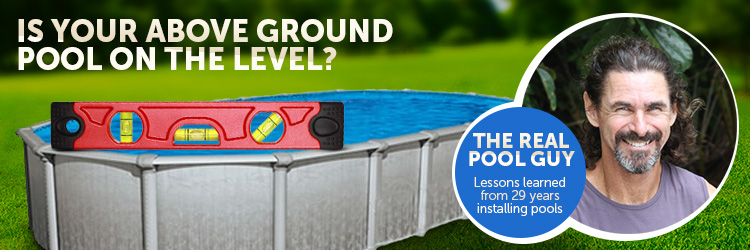Here are some videos that will help you level your site. The first one shows how to use a water level to find the high and low spots in the yard.
This video shows how to use a board and level on a pivot point to make leveling adjustments across the area for the floor of the pool.
Step by step instructions:
How to Install a Temporary Seasonal Pool (Intex, Summer Escapes, ect)
Materials needed: Shovel, concrete patio blocks, a straight 2’x4’x8’ board, measuring tape, nut grass killer, ground tarp, TF 100 test kit.
Basic Instructions:
1. First and foremost the ground under the pool must be level and firm. Remove the grass from the area to be leveled 2 feet wider than the stated diameter of the pool. (For an 18’ pool remove a 20’ circle of grass)
2. Find the lowest point of the perimeter of the circle and use that as your reference to level the ground. Dig away the high spots inside the circle. Check for level using a 3’ long level on top of a straight 2’x4’x8’ board.
3. Once the ground is level tamp down the soil with a plate compactor or a roller compactor. (usually may be rented at hardware stores) Saturate the soil with nut-grass killer. At this point you may spread a thin layer of sand to smooth and cushion the pool floor. Lay down the ground tarp.
4. Lay out patio blocks where the upright supports will go. Dig out the area under the blocks so they will lay level with the ground.
5. Lay out the pool liner so the openings for the intake and return are positioned as close to your source of electricity as possible. Assemble the pool according to the manufacturer’s directions.
6. Fill pool with 12” of water and check frame for level. Pool should be within 1” of level for maximum safety. Adjust upright supports if needed at this time.
7. Connect the pump/filter and continue filling the pool.
8. Follow manufacturer’s instructions for operating the filter/pump.
9. Use the pool calculator to determine how much CYA and FC you need for your pool.
10. Use your TF 100 to test the water and balance as needed.
You must use pavers under the legs of the pool. Larger, thicker pavers are best. The pavers help spread out the downward forces on the pool legs, so the legs will be less likely to sink into the soil when the pool is full. Think of it this way, the leg of the pool is like a stilletto heel on a high heeled shoe. If you try to walk on a lawn wearing stilletto heels you are going to sink into the ground. Now think of the paver as a 1" flat heel. You can walk on the lawn all day in those without getting stuck in the ground!



![60346[1].jpg 60346[1].jpg](https://www.troublefreepool.com/data/attachments/86/86249-465ec9c9775c73919fb1c0377a8a1371.jpg)